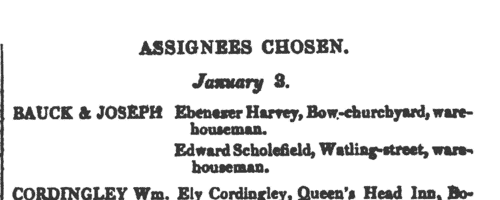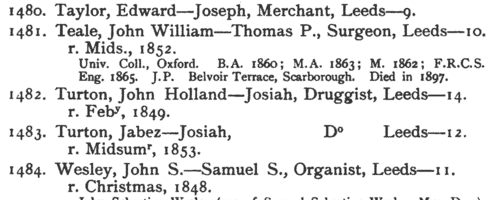Our indexes include entries for the spelling taylor. In the period you have requested, we have the following 7,644 records (displaying 3,301 to 3,310):
Deaths, Marriages, Literary News, Bankrupts, Patents, and Dissolutions of Partnerships
(1823)
English death, marriage and birth notices, bankruptcies, certificates and dividends, dissolutions of partnerships, literary news, and patents, as reported in the European Magazine. Includes some marriages and deaths from Ireland, Scotland and abroad, and Scottish sequestrations (bankruptcies). July to December 1823.
| Sample scan, click to enlarge

|
Deaths, Marriages, News and Promotions
(1823)
Death notices and obituaries, marriage and birth notices, civil and military promotions, clerical preferments and domestic occurrences, as reported in the Gentleman's Magazine. Mostly from England and Wales, but items from Ireland, Scotland and abroad.
| Sample scan, click to enlarge

|
Deaths, Marriages, News and Promotions
(1823)
Death notices and obituaries, marriage and birth notices, civil and military promotions, clerical preferments and domestic occurrences, as reported in the Gentleman's Magazine. Mostly from England and Wales, but items from Ireland, Scotland and abroad.
| Sample scan, click to enlarge

|
Mathematics students at Cambridge University
(1823)
Tripos lists or examination results for the year, arranged by class (Wranglers, Senior Optimes and Junior Optimes), and within each class in order of score in the examination (the names of candidates with equal scores are bracketed together, with the word 'AEq.'). Each student's surname and college is given: this list was printed in 1890, and was annotated with asterisks to show which students had subsequently become fellows of the university; and with footnotes showing those who became headmasters, &c., elsewhere. Winners of Dr Smith's Mathematical Prizes are marked (1) senior, (2) for junior. These lists are particularly useful in identifying for an individual the fellow-students who will have attended lectures with him; and, where from the college, are likely to have been even more closely associated by having been under the same supervisor. (The sample scan is from the start of the Mathematics Tripos list for 1770) | Sample scan, click to enlarge

|
Preferments of Anglican Clergy
(1823)
The Christian Remembrancer, a monthly publication, included these lists of Ecclesiastical Preferments as part of its Miscellaneous Intelligence. Each entry usually gives the clergyman's surname and christian name, a description of the benefice (R. rectory, V. vicarage), and may identify the patron. These lists are from volume 5, issued in 1823. | Sample scan, click to enlarge

|
Bankrupts in England and Wales
(1824)
The Law Advertiser printed details of the progress of the administration of bankrupts' estates. One section was the choosing of assignees. This is the index to the bankrupts themselves, rather than the assignees. Under the heading 'Assignees Chosen', the bankrupts' surnames are given in capitals, often with the christian name in lower case; and then the name, occupation and address of the assignees. The assignees were often principal creditors, often relatives of the bankrupt. January to December 1824. | Sample scan, click to enlarge

|
Bankrupts in London
(1824)
English bankrupts could be dealt with in the provinces (Country) or London (Town). Town proceedings covered not only London but many provincial cases. The weekly Law Advertiser printed this London Bankrupt Diary, detailing the progress of Town cases as they went through the various stages of hearings towards the surrender, realisation and distribution of the bankrupt's assets. | Sample scan, click to enlarge

|
Bankrupts outside London
(1824)
English bankrupts could be dealt with in the provinces (Country) or London (Town). Town proceedings covered not only London but many provincial cases. The weekly Law Advertiser printed this Country Bankrupt Diary, detailing the progress of Country cases as they went through the various stages of hearings towards the surrender, realisation and distribution of the bankrupt's assets. | Sample scan, click to enlarge

|
Boys entering Leeds Grammar School
(1824)
The admission books for Leeds Grammar School from 1820 to 1900 were edited by Edmund Wilson and published in 1906. The series of registers is almost complete for the period, there being in addition admission registers for the Lower (or Commercial) Department from 1856 to 1865, and lists of boys in the school in 1856, and in the Commercial Department in 1861. The entries are arranged by date or term of admission: a sequential number is given first, then surname, christian name, and, after a dash, father's christian name, occupation, and address; another dash, and then the age of the boy at admission, and often his year of leaving (with the abbreviation r. for 'removed' or 'left'). r.* means left without notice; (o) or S. or Stranger or Foreigner indicates a boy not on the foundation. The editor was unable to divine the meaning of the abbreviation (Q) or the asterisks prefixed to most entries in 1856 to 1860, but dutifully copies them into the text. In smaller type he then proceeds, where possible, to add some information about the boy's subsequent career. | Sample scan, click to enlarge

|
Deaf and Dumb Boys
(1824)
At a general meeting of the committee of the Deaf and Dumb Asylum, London, held 12 July 1824, fifteen boys and fifteen girls were elected for admission. | Sample scan, click to enlarge

|
Research your ancestry, family history, genealogy and one-name study by direct access to original records and archives indexed by surname.











